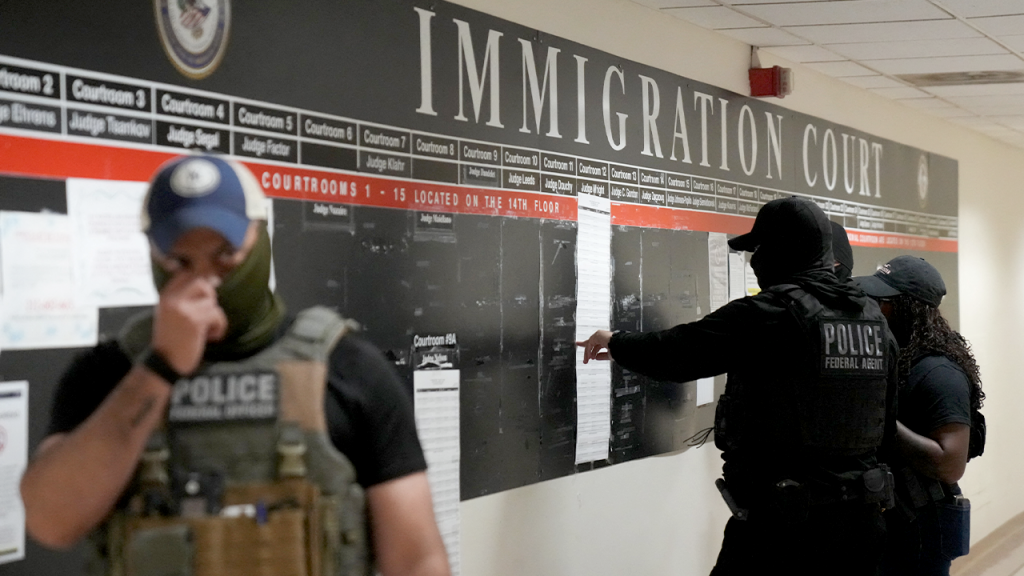Tensions Rise as Chicago Judge Blocks ICE from Making Courthouse Arrests
In a significant move that highlights the ongoing tension between local jurisdictions and federal immigration enforcement, a Chicago judge recently signed an order prohibiting Immigration and Customs Enforcement (ICE) from making arrests at Cook County courthouses. The decision, made by Cook County Circuit Chief Judge Timothy Evans, was based on his belief that justice fundamentally “depends on every individual’s ability to appear in court without fear or obstruction.” This ruling represents another chapter in the complex story of sanctuary cities like Chicago, which have long been at odds with the Trump administration’s aggressive immigration policies. The order specifically bans immigration authorities from making civil arrests of any “party, witness, or potential witness” during court appearances, effectively creating a safe zone for undocumented immigrants who need to participate in court proceedings.
The backdrop to this judicial decision is a troubling pattern that local officials have observed: people avoiding court appearances altogether out of fear of being detained by ICE. This avoidance creates a cascade of problems within the justice system, as cases cannot proceed without all parties present, witnesses may not testify, and victims might not seek justice. The Chicago order comes after the Trump administration launched an initiative in June specifically targeting illegal immigrants for arrest after asylum hearings. This tactic has proven deeply controversial, with critics arguing that it discourages migrants seeking legal pathways to citizenship from attending their hearings. Furthermore, many have pointed out that those arrested after hearings may not have additional criminal histories, suggesting the policy may be casting too wide a net in its enforcement approach.
The practice of courthouse arrests has sparked emotional reactions across the country, with videos of such arrests going viral on social media platforms. Some observers have used strong language to describe these actions, even characterizing them as “kidnapping” migrants who are simply trying to navigate the legal system. The emotional impact of these arrests extends far beyond the individuals directly affected, creating ripple effects throughout immigrant communities. Diana Konaté, deputy executive director of Policy and Advocacy at African Communities Together, captured this sentiment in a statement published by the ACLU, explaining that “Every day, our members are forced to choose between being kidnapped and/or put into expedited removal or risking deeper legal consequences because they’re too scared to go to court.” Her statement highlights the impossible choice many immigrants feel they face when interacting with the court system.
The Chicago ruling stands in contrast to a recent federal case in New York City, where immigrant rights groups and the ACLU filed a lawsuit challenging similar ICE courthouse arrest policies. In that instance, a federal judge ruled there was insufficient evidence to suggest that ICE’s courthouse arrest policy changes were “unexplained, arbitrary and capricious” following 2021 guidance that permitted arrests at or near immigration courts. This inconsistency between jurisdictions reflects the complex legal landscape surrounding immigration enforcement in the United States, with different courts reaching different conclusions about the proper limits of federal authority. The divergent outcomes also demonstrate how immigration enforcement has become increasingly dependent on local judicial interpretations, creating a patchwork of enforcement realities across the country.
The situation in Chicago exemplifies the broader tensions between sanctuary cities and the federal government’s immigration enforcement priorities. Chicago has long identified itself as a sanctuary city, meaning local authorities limit their cooperation with federal immigration enforcement actions. The Trump administration has specifically targeted such cities in its immigration crackdown, creating an ongoing power struggle between local and federal authorities. Some judges across the country have taken even more dramatic steps in opposition to ICE courthouse arrests, with reports suggesting that some have allegedly aided migrants in escaping after hearings. These actions reflect the profound ethical and legal questions that courthouse arrests raise for those tasked with administering justice.
At its core, this controversy represents fundamental questions about access to justice in America. Advocates for immigrants argue that courthouse arrests effectively deny access to the legal system for an entire class of people, undermining core principles of due process and equal protection. They contend that when people avoid court out of fear of deportation, the entire justice system suffers – cases go unresolved, crimes go unpunished, and civil disputes remain unsettled. On the other hand, supporters of aggressive immigration enforcement argue that the law must be applied consistently, regardless of location, and that courthouses are logical places to find individuals whose immigration status is in question. As Konaté noted in her statement, the climate of fear may be exactly “what the administration intended—for people to be so fearful of enforcement that they forfeit the very resources and systems in place to protect them.” As this Chicago case demonstrates, the balance between immigration enforcement and access to justice remains a contentious and unresolved issue in American society, with profound implications for both our legal system and the millions of undocumented immigrants living within our borders.


